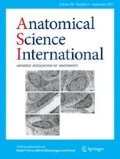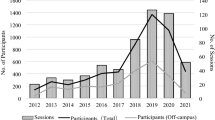Abstract
Cadaver surgical training (CST), which aims to maintain patient safety, provided anatomists with new duties and increased their workload. In Japan, with development of relevant guidelines, CST programs have been implemented and promoted mainly by surgical societies. This paper examines ethics of and anatomists’ attitude toward the Japanese CST guidelines. The guidelines were well established to ensure that ethical issues such as financial exploitation and commercialism involved in procurement of cadavers for training do not emerge, as these can create the dilemma of how to allocate cadavers for undergraduate education and postgraduate surgical training, given the increase in demand for cadavers. Fair allocation must accommodate and respect the donor’s advance will. Also, the guidelines must offer more detailed commentary on informed consent, particularly with regard to disclosure of information to donor candidates. The guidelines should explain better the legality of CST, the roles of anatomists, and surgeon preparedness.
Similar content being viewed by others
References
Asai A, Kadooka Y, Aizawa K (2012) Argument against promoting organ transplants from brain-dead donors, and views of contemporary Japanese on life and death. Bioethics 26:215–223
Bazerman MH, Tenbrunsel AE (2011) Chapter 2: why traditional approaches to ethics won’t save you. in: blind spots: why we fail to do what’s right and what to do about it (Japanese Translation). NTT Shuppan, Tokyo, pp 33–53 (In Japanese)
Champney TH (2016) The business of bodies: ethical perspectives on for-profit body donation companies. Clin Anat 29:25–29
Hopper AN, Jamison MH, Lewis WG (2007) Learning curves in surgical practice. Postgrad Med J 83:777–779
Ito H, Imura H, Takaku F eds (2003) Kaibou. In: Igaku-shoin’s medical dictionary. Igakushoin, Tokyo, pp 334 (In Japanese)
International Federation of Association of Anatomists (2017) Recommendations of good practice for the donation and study of human bodies and tissues for anatomical examination. http://www.ifaa.net/wp-content/uploads/2017/09/IFAA-guidelines-220811.pdf. Accessed 27 Jan 2022
James H (2020) Use of cadavers to train surgeons: what are the ethical issues? J Med Ethics 46:470–471
Japan Surgical Society, The Japanese Association of Anatomists (2012) Guidelines for cadaver dissection in education and research of clinical medicine. Acta Anat Nippon 87:21–23 (In Japanese)
Japan Surgical Society, The Japanese Association of Anatomists (2018) Guidelines for cadaver dissection in education and research of clinical medicine (revised version). https://jp.jssoc.or.jp/uploads/files/aboutus/guidelines/info20180406-01.pdf. Accessed 24 Dec 2021 (In Japanese)
Jones DG (2020) From undergraduate to postgraduate uses of the dead human body: consequential ethical shift. J Med Ethics 46:474–475
Kondo S (2010) Study of effective surgical training systems. FY2009 MHLW Research Grant. Research on promoting the development of foundations of community healthcare (In Japanese)
LEX/DB Internet (online law reports) 27680563: a case violating the Postmortem Examination and Corpse Preservation Act. The Tokyo High Court in 1953. No.3440. https://lex.lawlibrary.jp/lexbin/DBSelectAC.aspx (In Japanese)
LEX/DB Internet (online law reports) 28031226: A suit for damages. The Spreme Court in Japan in 1998. No.576. https://lex.lawlibrary.jp/lexbin/DBSelectAC.aspx (In Japanese)
Machino S (2018) Basic knowledge of medical ethics in 2018. The postmortem examination and corpse preservation act and surgical training. https://www.med.or.jp/doctor/rinri/i_rinri/h05.html (In Japanese) (Accessed 21 Dec 2021)
Nagoya S, Suzuki D, Teramoto A et al (2020) A role of cadaver surgical training as a translational research in a field of the pelvis and the lower limb. J Jt Surg 39:39–44 (In Japanese)
Nihon Tokushi Kentai Kyokai (2020) Kentai toha. http://www.kentai.or.jp/what/01whatskentai.html (In Japanese)
Nuffield council on bioethics (2011) Human bodies: donation for medicine and research. (Accessed 21 Jan 2022) https://www.nuffieldbioethics.org/publications/human-bodies-donation-for-medicine-and-research
Science Council of Japan (1990a) Report-anatomy education and research in Japan- (discussion of present situation and future prospects) (1) https://www.scj.go.jp/ja/info/kohyo/12/14-13.pdf. Accessed 26 Jan 2022 (In Japanese)
Science Council of Japan (1990b) Report-anatomy education and research in Japan- (discussion of present situation and future prospects) (2) https://www.scj.go.jp/ja/info/kohyo/12/14-13_2.pdf. Accessed 26 Jan 2022 (In Japanese)
Shichinohe T, Kobayashi E (2021) Cadaver surgical training in Japan: its past, present, and ideal future perspectives. Surg Today. https://doi.org/10.1007/s00595-021-02330-5 (Published online: 05 July 2021)
Slowther AM (2020) Use of cadavers to train surgeons: respect for donors should remain the guiding principle. J Med Ethics 46:472–473
Takamura K, Tsurumoto T (2020) Achieve and future prospects of cadaver surgical training at Nagasaki University. J Jt Surg 39:22–27 (In Japanese)
The Japanese Association of Anatomists (2012) A view of the Japanese association of Anatomists on guidelines for cadaver dissection in education and research of clinical medicine. Acta Anat Nippon 87:25–26 (In Japanese)
The Japanese Association of Anatomists (2013) Differences between traditional education and research in clinical anatomy conducted by anatomical departments and surgical training defined by the guidelines for cadaver dissection in education and research of clinical medicine. Acta Anat Nippon 88:69–70 (In Japanese)
The Japanese Association of Anatomists (2020) Questionnaire investigation report on the current state and issues of Technical Staff in Anatomy Department. Acta Anat Nippon 95:12–22 (In Japanese)
Walker TA, James HK (2020) Use of cadavers to train surgeons: what are the ethical issues? Body donor perspective. J Med Ethics 46:476
Acknowledgements
The author would like to thank Prof. Fukuda, Prof. Wakayama, and Ms. Nishimura for kindly providing detailed information and explanations on the current state of anatomy practice and CST in Japan.
Author information
Authors and Affiliations
Corresponding author
Ethics declarations
Conflict of interest
None declared.
Research grants from funding agencies
The author has not received any grants for this work.
Participant consent for publication
Not required.
Additional information
Publisher's Note
Springer Nature remains neutral with regard to jurisdictional claims in published maps and institutional affiliations.
Rights and permissions
About this article
Cite this article
Kadooka, Y. Ethical perspectives on the Japanese guidelines for cadaver surgical training (CST). Anat Sci Int 97, 316–322 (2022). https://doi.org/10.1007/s12565-022-00670-x
Received:
Accepted:
Published:
Issue Date:
DOI: https://doi.org/10.1007/s12565-022-00670-x



